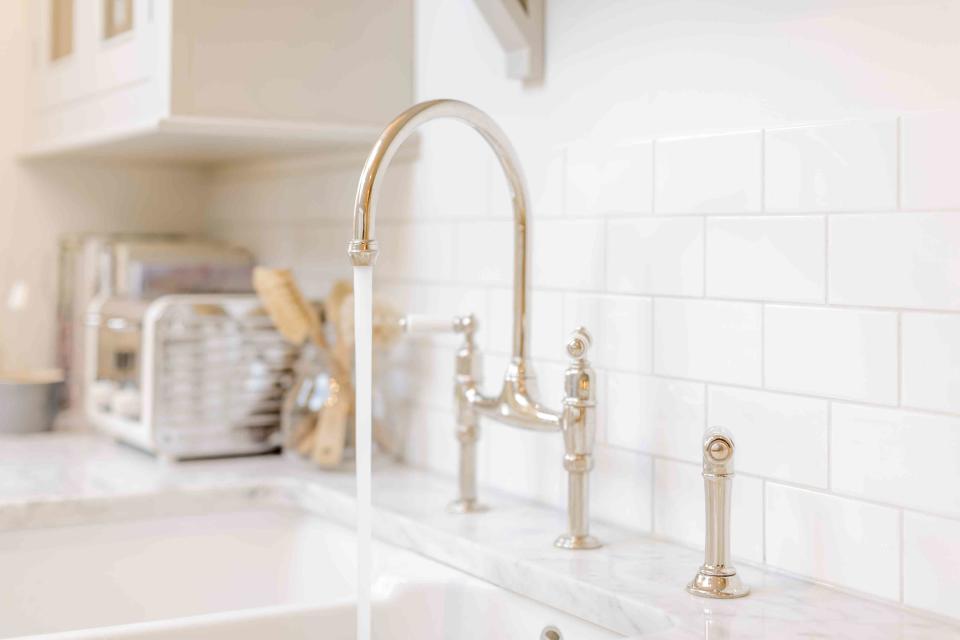15 Household Items You Should Never Clean With Water
Protect these items from damage by not using water to clean them.

Caia Image/Getty Images
Water is a staple when it comes to household cleaning. It can be used on its own, with soap, or combined with other cleaning agents, like baking soda and vinegar. But despite its versatility, water should be used sparingly for some cleaning tasks. Excessive water can harm certain materials and may leave behind stains, cause warping, and even lead to sealant damage. To protect the surfaces and items in your home, we're sharing a few things experts say you should never drench with water.
Meet the Expert
Kathy Cohoon, director of franchise operations of Two Maids
Alicia Sokolowski, president and co-CEO of AspenClean
Related: 4 Ways to Remove Water Stains From Wood, According to Cleaning Experts
Wood Furniture
Excess moisture can cause wood furniture to swell, warp, and split, which is why water can damage the material. "If wood is painted or finished, water can also damage the finish, so always opt for wood-specific cleaning products, says Kathy Cohoon, the director of franchise operations of Two Maids.
Wood Flooring
Like wood furniture, it's best to use water very sparingly when cleaning wood flooring. "Wood floors are sensitive to moisture and excess dampness can lead to swelling, warping, and cupping of flooring," says Cohoon. "Finishes can also chip, become discolored, or look worn."
Brick
Avoid cleaning exposed brick with excessive water as it can dissolve salts and minerals in the brick, resulting in powdery deposits that make the brick look dirty. Additionally, if water penetrates the pores of the bricks and then freezes, it can cause the water to expand, leading to cracking and spalling of the brick surface, says Alicia Sokolowski, president and co-CEO of AspenClean.
Marble
Marble is a porous, softer stone, meaning cleaning with water can lead to staining, etching, and sealant damage, especially when you use too much moisture, says Cohoon. "Using any water can be problematic for certain types of marble, so always check manufacturer’s instructions when trying to clean marble," she says.
Related: How to Clean Every Type of Kitchen Countertop
Stucco
Like marble, stucco is also a porous material and can be damaged from cleaning with water. "Using excessive water can cause absorption that can lead to swelling, cracking, or crumbling," says Cohoon. "Water can also leave behind mineral deposits that can stain, and if stucco remains damp it becomes a hotbed for mold and mildew."
Brass
While brass—a mixture of copper and zinc—is generally a durable and corrosion-resistant material, improper cleaning can lead to several issues, says Sokolowski. Cleaning brass with water may cause water stains, tarnish, corrosion, and the formation of green patina.
Silver
Water can leave stains on silver, causing the material to tarnish faster and contribute to corrosion. "Silver items also often incorporate gemstones or enamel," says Sokolowski. "Water can seep into crevices and under settings, potentially causing damage to these delicate elements."
Related: The Right Way to Clean and Polish All of Your Silver Pieces, From Flatware to Jewelry
Leather
It's best to use a designated leather cleaner rather than water on leather. "Water can cause staining and damage to the material while leaving stains on the surface or discoloration," says Cohoon. "Over time, excess moisture can warp leather and deplete the natural oils, which will make it dry out and become brittle." A little bit of water can be used to spot clean leather, but you should never drench the material in water.
Velvet
Velvet is incredibly sensitive to water, as it can leave behind visible marks and stains in the fabric, says Cohoon. Additionally, water can also damage the texture of velvet and make it seem matted or discolored.
Silk
Water can weaken the fibers of silk, which may cause the material's texture to change. Additionally, excessive moisture can leave stains and cause the colors on silk to bleed or fade over time, says Cohoon.
Suede
Suede is particularly prone to water stains. "When water comes into contact with suede, it will leave behind visible marks as it dries, altering the appearance of the fabric," says Sokolowski. "Also, water exposure can cause color bleeding or fading in suede, especially in dyed suede items."
Related: How to Clean Suede Shoes and Boots at Home
Electronics
Using water on electronics can be dangerous to you and harmful to your items. "If water comes into contact with some electronic components and circuits, it can create short circuits or electrical connections where they shouldn't exist," says Sokolowski. "This can lead to malfunctions, permanent damage such as corrosion, component damage, or even electrical fires."
Outlets
For both outlets and light fixtures, cleaning with water can run the risk of electric shock and device damage, says Cohoon. It may also lead to corrosion and rust in the outlet or fixture.
Light Fixtures
Cleaning light fixtures with water can damage the bulb and socket. "Also, water exposure can compromise the insulation on wires within the light fixture," says Sokolowski. "This can lead to deterioration of the wiring, increasing the risk of electrical faults and posing a potential fire hazard."
Gas Range Burners
Cleaning your gas range burners with water can cause ignition issues. "Water in or around the burner ignition system can cause electrical components to malfunction (or even failure of the whole system)," says Sokolowski. Water can also do damage to the gas valves or control knobs, as well as lead to corrosion and rust.
Read the original article on Martha Stewart.

